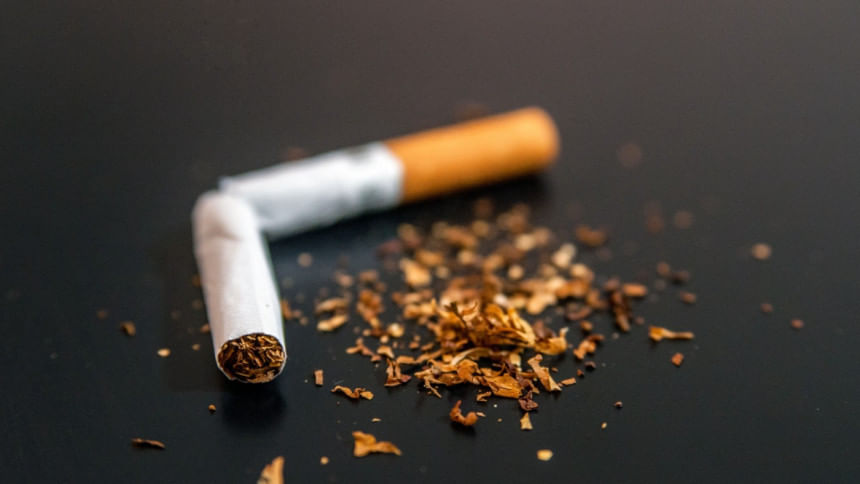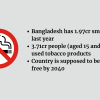Are tobacco taxes really working in Bangladesh?

Bangladesh is among the highest tobacco-consuming countries in the world. The National NCD Risk Factors Survey 2022 by the Directorate General of Health Services (DGHS) reported that around 39.4 percent of adults aged 18–69 used tobacco in some form, with usage at around 54.7 percent among men and 25.4 percent among women. In comparison, global smoking prevalence in 2023 was 22.3 percent, of which men were 28.1 percent and females were 4.7 percent, according to the World Health Organization (WHO).
One of the strongest instruments for curbing tobacco use is taxation, which works in two ways. Increasing taxes reduces the prevalence of smoking and deters new smokers from ever taking up the habit. The logic is straightforward: higher taxes push prices up, discouraging new and price-sensitive smokers, and at least nudging others to cut down.
However, Bangladesh has a complex tax policy system for tobacco products. The government relies on a tiered ad valorem supplementary duty (SD) on the retail price, 15 percent VAT, and a one percent Health Development Surcharge (HDS). There are four tiers, and therein lies the problem. When taxes rise across all segments, smokers can easily switch from premium to low-tier brands, keeping consumption stable. This system benefits tobacco companies as well, since customers do not leave the market. British American Tobacco Bangladesh's (BATB) 2024 annual report shows that low-segment brands account for the largest share of its sales volume.
Compounding this is the issue of consumers being able to buy single-stick cigarettes. Midway through FY2024–25, the government hiked VAT and SD on over 100 goods and services, including cigarettes. However, the prices of some of the popular brands selling loose are still quite affordable—between Tk 20 to Tk 10—for low-income populations and even the youth, particularly schoolchildren, who are potential new smokers.
Bangladesh is committed to becoming a smoke-free nation by 2040, which is now only 15 years away. Yet, there is no updated national-level data to show whether tobacco use is declining or rising. The last STEPS survey, based on World Health Organization's approach to noncommunicable disease (NCD) risk factors surveillance, was in 2018; the last Global Adult Tobacco Survey (GATS) was in 2017. Although the DGHS conducted a NCD Risk Factor survey in 2022, the official report has not yet been released publicly. Without updated evidence, how can policymakers steer the country toward its stated goal and design interventions when the present baseline is not known?
In the absence of updated data and given the limited public data available, proxy indicators can be used to show whether the situation is improving or worsening. Taxes to the exchequer have risen over the past decade, and tobacco companies' revenues and profits have climbed steadily. Taken together with the persistence of affordability and continued down-trading into lower tiers, this indicates that the current tax design is not working as intended. If taxation were effective, retail prices would increase and consumption would decline, so overall revenue would likely decline. Instead, revenues are soaring.
Evidence consistently shows that the economic costs of tobacco use far exceed the revenue governments collect from tobacco taxes. In 2017–18, Bangladesh collected Tk 22,810 crore in tobacco tax (SD + VAT). Yet the economic cost of tobacco use from lost productivity and direct healthcare costs of smoking-related illnesses was estimated at Tk 30,560 crore in the same year.
As public health is not in focus and with no effective national health financing strategy in place, people are left in a doubly vulnerable situation. The low-income population, in particular, often lacks full awareness of the health consequences of smoking. With out-of-pocket health expenses at around 73 percent in 2021 and showing a rising trend over the past two decades, many families slip into poverty when faced with treatment costs stemming from tobacco-related illnesses. They are forced to sell assets, take on heavy loans, and shoulder crushing financial burdens to pay for the treatment of diseases caused by smoking. In 2018 alone, nearly 126,000 people in Bangladesh died from tobacco-related diseases.
Now, tobacco companies may continue to parade their status as among the country's "highest taxpayers." The government, too, may feel pressured to tread lightly, fearing a loss of revenue if tougher policies are imposed. But the government must realise that this trade-off cannot be justified. The citizens of this country should not bear the burden of a system that values revenue over lives. The constitution obliges the state to protect the health of its people.
Cigarette sales and taxation are only instruments for revenue collection. If revenue generation is truly the concern, the government must explore other avenues. It should work with economists, health experts, researchers and all other relevant stakeholders to identify sustainable, equitable alternatives. Bangladesh has pledged to its people and to the world that it will be smoke-free by 2040. That pledge cannot remain hollow words.
Mohammad Ihtesham Hassan is research associate at the Power and Participation Research Centre (PPRC).
Views expressed in this article are the author's own.
Follow The Daily Star Opinion on Facebook for the latest opinions, commentaries and analyses by experts and professionals. To contribute your article or letter to The Daily Star Opinion, see our guidelines for submission.

 For all latest news, follow The Daily Star's Google News channel.
For all latest news, follow The Daily Star's Google News channel. 










Comments